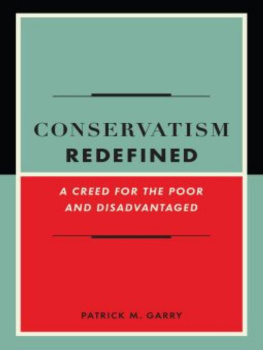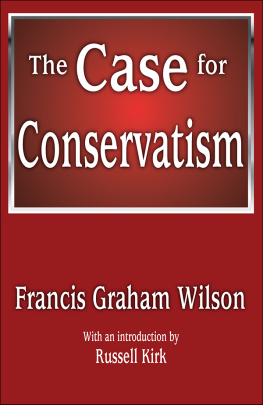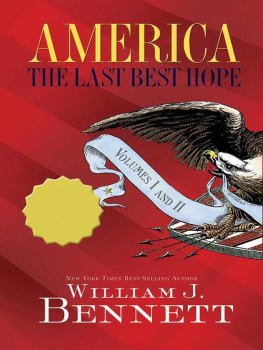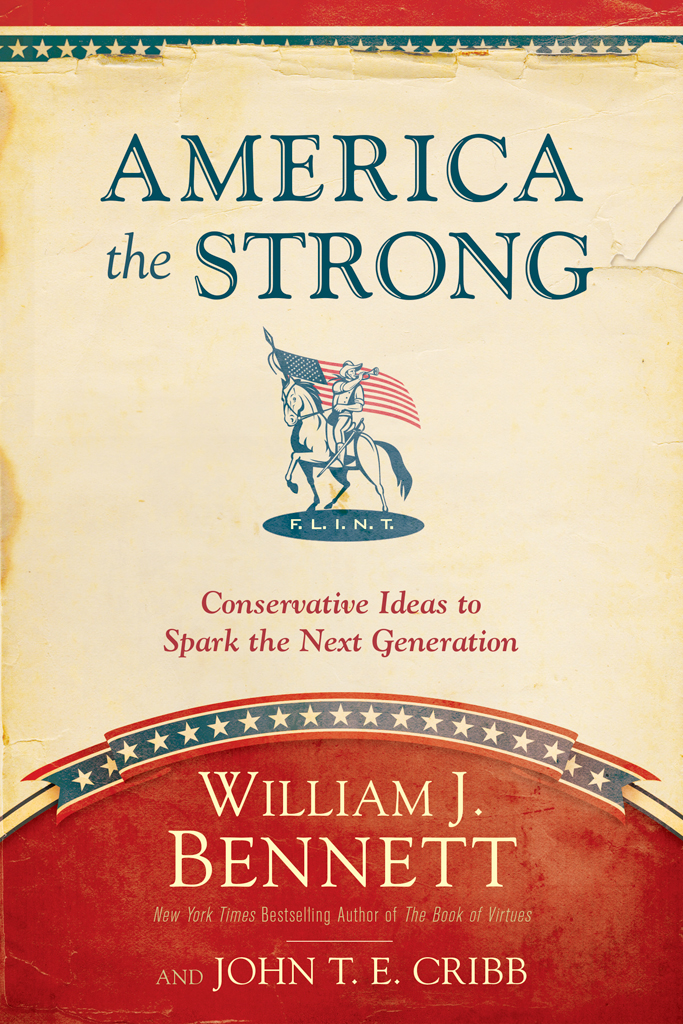Visit Tyndale online at www.tyndale.com.
TYNDALE and Tyndales quill logo are registered trademarks of Tyndale House Publishers, Inc.
America the Strong: Conservative Ideas to Spark the Next Generation
Copyright 2015 by William J. Bennett and John T. Cribb. All rights reserved.
Cover illustrations and background design are the property of their respective copyright holders and all rights are reserved: patriotic background 719production/Dollar Photo Club; stars border DAVIDS/Dollar Photo Club; illustration of American cavalry Patrimonio Designs Ltd/Shutterstock.
Designed by Jacqueline L. Nuez
Cumulative Final Rules Published in the Federal Register, 19932013 (page 67) was originally published in Clyde Wayne Crews, Ten Thousand Commandments: An Annual Snapshot of the Federal Regulatory State (Competitive Enterprise Institute, 2014). Used by permission.
Total Welfare Spending (page 84), Unwed Birth Rate (page 199), and Religious Attendance (page 216) were originally published in the 2014 Index of Culture and Opportunity, edited by Jennifer A. Marshall and Rea S. Hederman Jr. (The Heritage Foundation, 2014). Used by permission.
Where Does Every Dollar in Spending Go? (page 94), U.S. National Debt 1965 to 2014 (page 103), and Defense Spending As a Share of the Economy (page 168) were originally published in Romina Boccia, Federal Spending by the Numbers, 2014: Government Spending Trends in Graphics, Tables, and Key Points (Including 51 Examples of Government Waste) (The Heritage Foundation, 2014). Used by permission.
Trends in Public Schooling since 1970 (page 233) appears in Andrew J. Coulson, Public School Spending. Officials vs. Some Critics, Cato at Liberty (blog), May 22, 2013, http://www.cato.org/blog/public-school-spending-achievement-media-coverage. Used by permission.
Unless otherwise indicated, all Scripture quotations are taken from the Holy Bible, King James Version.
Scripture quotations marked NLT are taken from the Holy Bible, New Living Translation, copyright 1996, 2004, 2015 by Tyndale House Foundation. Used by permission of Tyndale House Publishers, Inc., Carol Stream, Illinois 60188. All rights reserved.
Scripture quotations marked RSV are taken from the Revised Standard Version of the Bible, copyright 1952 [2nd edition, 1971] by the Division of Christian Education of the National Council of the Churches of Christ in the United States of America. Used by permission. All rights reserved.
Library of Congress Cataloging-in-Publication Data
Bennett, William J. (William John), date.
America the strong : conservative ideas to spark the next generation / William J. Bennett and John T.E. Cribb.
pages cm
Includes bibliographical references.
ISBN 978-1-4964-0593-7 (hc)
1. ConservatismUnited StatesHistory21st century. 2. ValuesUnited StatesHistory21st century. I. Cribb, John T. E. II. Title.
JC573.2.U6B46 2015
320.520973dc23 2015013275
ISBN 978-1-4964-0975-1 (ePub); ISBN 978-1-4964-0594-4 (Kindle); ISBN 978-1-4964-0976-8 (Apple)
Build: 2015-06-24 15:13:05
INTRODUCTION
T HE PURPOSE OF THIS BOOK IS to explain what conservatism means. It explains basic conservative principles, the reasons conservatives stand for them, and how they apply to challenges our country faces.
We live in a time when many Americans feel uncertain about the future. They worry about jobs and the economy. They worry about whether the next generation will have a standard of living as high as previous ones. Distrust of major political institutions runs deep. There are concerns about whether the country is on the right path, and even if it might be in decline.
Conservative principles speak to these problems. The United States was founded on conservative principles, and they helped America become a great and strong nation. They can help keep it strong for generations to come.
For that to happen, each generation must pass those principles on to the next. Each generation has to offer clear explanations of certain ideas and values to young people as they reach adulthood. That responsibility has much to do with whether the next generations future is dim or bright.
The idea for this book grew from questions a smart teenager asked her dad, one of the books coauthors, John Cribb. The questions came during their drives to school while listening to Bill Bennetts Morning in America, the conservative talk radio show hosted by this books other coauthor.
Questions like Why do terrorists want to kill Americans? and What do you think about global warming? and Why shouldnt rich people pay all the taxes?
And this one: Exactly what is a conservative, anyway?
Theyre the kind of questions some bright young people start to ask when theyre in high school or college, or perhaps when they start to vote or get their first full-time job. Questions they ask when they begin to realize that events in the news really do affect them, their family, their friends, and their country.
What is a conservative? This book answers that question and more than a hundred others about issues ranging from immigration to illegal drugs. It examines issues from a conservative standpoint and explains why conservative ideas are good for our country.
If you are a young person just beginning to pay attention to current affairs and politics, there are a couple of things you should know. The first is that nearly 40 percent of Americans consider themselves conservative. Nearly 25 percent consider themselves liberal (the opposite of conservative). So conservatives outnumber liberals by a fairly wide margin.
The second thing you should know is that despite their numbers, conservatives sometimes face questions and even sneering remarks about the values they stand for. Portions of the culture tend to depict conservatism as backward and wrongheaded. They may try to convince you that conservatives are mean-spirited, greedy, prejudiced people.
Most of the national mainstream media news organizations in the United States have a strong liberal bias. That includes ABC, CBS, NBC, CNN, MSNBC, PBS, and NPR. (Fox News is the major exception.) It also includes influential newspapers like the New York Times and the Washington Post.
Hollywood, likewise, is a famously liberal place, and many of the television programs and movies it produces have the same bias. They carry messages that belittle the values and attack the institutions many Americans respectmessages like sleeping around is fine, religious people are nuts, and businessmen dont care about poor people or the environment.
College campuses may be the most anti-conservative places in the country. Liberal professors dominate most faculties. At many universities, conservative ideas are shouted down or cut off. Instructors feel free to mock conservatives in the classroom, and administrators pay scant attention when their posters are torn down or their sensibilities offended, writes a rare conservative Ivy League professor.
Liberal politicians routinely paint conservatives as mean-spirited extremists. President Barack Obama, for example, who is probably the most liberal president in history, told Republicans in Congress, Stop just hating all the time.
In short, several of Americas elite institutions give out anti-conservative messages, some subtle and some not so subtle. The bearers of those messages arent interested in helping anyone understand conservative principles. Theyre interested in smearing those principles and, if you are conservative, then maybe you, too.










